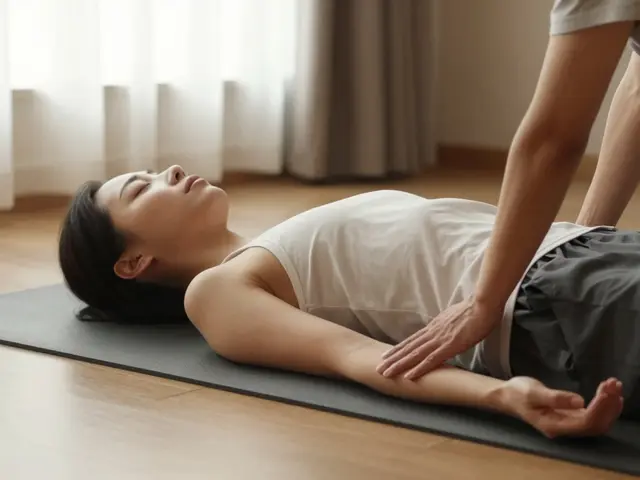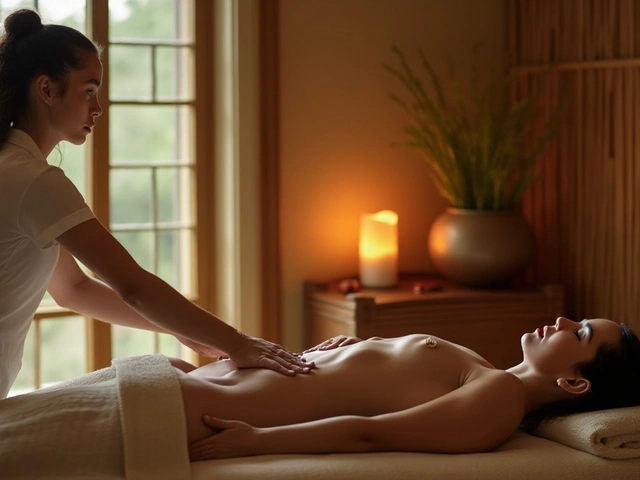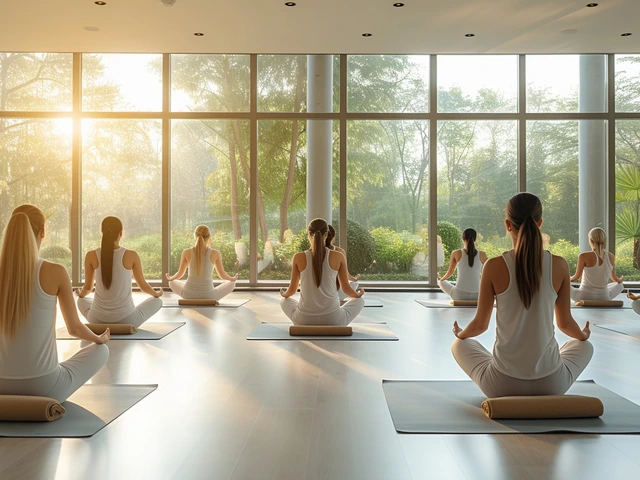How to Prepare for Your First Authentic Hammam Spa Experience

Ever wondered what it’s like to step into the soothing sanctuary of a traditional Hammam? Whether you're a seasoned spa-goer or new to the world of wellness, visiting a Hammam can be a transformative experience. Originating from ancient Ottoman and Moroccan practices, a Hammam visit is much more than just getting clean—it’s a ritual that encompasses cleansing, relaxation, and community.
It’s natural to feel a little unsure about what to expect and how to prepare for your first Hammam visit. This easy-to-follow guide will walk you through every step, helping you feel prepared and excited for what lies ahead. Let's embark on this journey towards relaxation and renewal together.
- Understanding Hammam
- What to Expect
- Pre-Visit Preparations
- Etiquette and Rituals
- During Your Visit
- Post-Visit Care
Understanding Hammam
The Hammam, also known as a Turkish bath, is a public steam bath originating from the Islamic world, with historical roots extending back to the Roman baths. It plays an essential role in spiritual and physical cleansing. Imagine intricate domed ceilings, marble chambers, and the gentle sound of trickling water—the atmosphere is designed to provide relaxation and rejuvenation. Visiting a Hammam is an immersive experience that combines bathing with social interaction, making it a place for relaxation as well as community bonding.
A typical Hammam has several distinct areas, each serving a specific purpose. You typically start in the warm room, known as the 'tepidarium,' which helps you acclimate to the heat. Moving forward, you enter the hot room, or 'caldarium,' where your body begins to sweat and release impurities. The steam in this room can be intense, encouraging deep cleansing. After spending time in the heated areas, you proceed to the cold room, or 'frigidarium,' to cool down, close your pores, and revitalize your senses.
One of the core elements of the Hammam ritual is the scrubbing process. A specially trained attendant, often called a 'tellak' in Turkish culture, uses a coarse mitt called a 'kese' to scrub off dead skin cells. This exfoliation leaves your skin feeling smooth and revitalized. Following the scrub, you might receive a foam wash with abundant, fragrant soap, culminating in a thorough rinse that leaves you feeling incredibly clean.
It is important to note that Hammams are deeply rooted in cultural and religious traditions, serving as significant communal places for centuries. According to Fatma Aksit, an expert in Middle Eastern studies,
"The Hammam is much more than a place to cleanse the body; it is an entwined fabric of various cultural, social, and even political life aspects in the Islamic world." This idea highlights the importance and reverence of Hammams beyond their physical benefits.
With modern adaptations, Hammams can now be found in many urban centers worldwide, offering a mix of traditional and contemporary spa treatments. Whether you’re visiting a classic Hammam in Istanbul or a modern version in a Western city, the *rituals* and *benefits* largely remain the same. Embracing the Hammam experience provides an excellent opportunity to connect with historical traditions while indulging in unparalleled relaxation and cleansing.
What to Expect
From the moment you step into a Hammam, you are greeted with a sense of serenity. The interiors are often adorned with intricate tilework, soothing fountains, and warm lighting, designed to transport you to another time. As a first-time visitor, it’s normal to feel a bit uncertain, but knowing what to expect can help ease any anxiety.
You'll typically start in a warm changing area where you’ll undress and wrap yourself in a traditional towel called a pestemal. Many Hammams offer secure lockers for your belongings. Moving into the warm room, your body will begin to acclimate to the heat, which is a key aspect of the Hammam ritual. Here, the ambient warmth helps to loosen your muscles and open your pores, preparing you for the cleansing process.
Next, you’ll be led into the hot room, where the temperature rises significantly. This space is designed to make you sweat, expelling toxins from your body. Some Hammams feature a large heated marble slab, known as a göbek taşı, where you can lie down and relax. The combination of heat and humidity helps to soften the skin, making it easier to exfoliate later on. According to a study published in the Journal of Complementary and Alternative Medicine, the heat therapy in Hammams can also improve cardiovascular health and reduce stress levels.
After sweating it out, an attendant will guide you through a series of cleansing rituals. This usually includes a vigorous scrub with a coarse mitt called a kese. The scrub can feel intense, but it’s incredibly effective at removing dead skin cells and leaving your skin feeling smooth and refreshed. If you’re not accustomed to this type of exfoliation, just remember that it's a key part of the Hammam experience and has been practiced for centuries to achieve glowing skin.
Following the scrub, you’ll be rinsed off with warm water and then lathered with fragrant soap, often made from olive oil. This is usually followed by a gentle massage, which can be deeply relaxing and therapeutic. Some Hammams also offer additional treatments like mud masks or aromatherapy, which can further enhance your experience.
Once the cleansing and massage are complete, you’ll be taken to a cooler room to relax and cool down. Here, you can sip on traditional mint tea and let your body recover from the heat. Many visitors find that this part of the process is the most rejuvenating, as it allows time for reflection and relaxation. According to an article in the New York Times,
“A visit to a Hammam is not just about cleansing the body, but also about cleansing the mind and soul. It’s an ancient practice that offers modern benefits.”
Having an idea of what to expect can make your first Hammam experience much smoother. The combination of heat, steam, and skilled treatments provides a unique way to unwind and rejuvenate. It’s a holistic experience that nurtures both the body and the spirit, leaving you feeling renewed and refreshed.

Pre-Visit Preparations
Getting ready for your first Hammam visit is key to enjoying a relaxing and rejuvenating experience. Knowing what to bring and what to expect will help you relax and immerse yourself fully in this ancient tradition. First, it's a good idea to research the specific Hammam you'll be visiting. Each has its unique style and set of rules, so understanding these can help you feel more confident and prepared.
One important thing to consider is what to wear to the Hammam. Many places provide a pestemal, a traditional Turkish towel to wrap around yourself, but it's always wise to confirm in advance. For modesty and comfort, you might want to wear swimwear beneath the pestemal, especially if you're not sure about the dress code. Don't forget to pack an extra pair of underwear to change into after your visit.
It's recommended to bring your personal hygiene items like shampoo and soap, as some Hammams might charge extra for these or might not have the products you're accustomed to. Additionally, flip-flops or waterproof sandals can be useful to navigate the wet, slippery floors of the Hammam.
Staying hydrated is crucial. The hot steam rooms can cause you to sweat a lot, so drink lots of water before your visit to keep from getting dehydrated. Some Hammams offer refreshments, but it's always best to be prepared.
Nourish your skin before you go. Consider exfoliating at home a couple of days before your visit. This will help remove dead skin cells, making the scrubbing process at the Hammam more effective. However, avoid doing this right before your visit because your skin might be more sensitive and could irritate the scrubbing process.
Managing your time properly is also crucial. Hammam rituals can take a few hours, so make sure to not rush and allow plenty of time to relax and enjoy the experience. Booking ahead is often necessary to guarantee a spot, particularly in larger or more famous Hammams, so plan accordingly.
“The hammam is a place where both physical and spiritual cleansing takes place, embodying centuries of tradition,Etiquette and Rituals
When you step into a traditional Hammam, you are not just entering a spa; you are immersing yourself in centuries of culture and tradition. Understanding the etiquette and rituals is essential to fully appreciate the Hammam experience.
Firstly, it’s important to know that Hammams are typically divided by gender. Most places have specific hours for men and women, so it’s essential to check the schedule before planning your visit. Upon arrival, you'll be given a peştemal, a traditional towel that you’ll wear inside the Hammam. This serves as both a cover and a symbol of modesty.
One of the first rituals you’ll encounter is a thorough rinse with warm water. This initial step is designed to open your pores and start the detoxification process. As you sit in the steam room, your body will begin to sweat, which helps in relaxing your muscles and softening your skin. The steam room is a communal space, and it’s important to maintain a respectful quietness to allow everyone to relax.
The Scrub
The heart of the Hammam experience is the exfoliating scrub, known as ‘gommage.’ A professional attendant will use a kese (an abrasive mitt) to scrub away dead skin cells from your body. This might feel intense if you’re not used to it, but it’s incredibly invigorating. You’ll be amazed at how much dead skin is removed. Remember to relax and trust the process—it’s all part of the deep cleansing ritual.
An expert Hammam attendant once explained, “The scrub is not just about cleaning the skin. It’s about revitalizing your whole body and letting go of stress.”After the scrub, you will be rinsed off with warm water. The steamy environment, combined with the vigorous scrub, leaves your skin feeling incredibly soft and rejuvenated.
The Bubbles
Next comes the foam massage, a blissful experience after the invigorating scrub. The attendant will cover you in a mountain of frothy suds using a special cloth sack known as a 'torba.' The foam massage is typically more gentle than the scrub, aimed at relaxing your muscles and soothing your skin.
While lying on the warm marble slab, you'll receive a light massage that works the soap into your skin, cleaning and hydrating it simultaneously. The combination of the warm marble, soothing foam, and gentle massage feels both luxurious and rejuvenating.
Final Rinse and Rest
After the foam massage, it’s time for a final rinse. You’ll be doused with cool water to close your pores and leave you feeling refreshed. This cooling step helps in bringing your body temperature back to normal gradually, ensuring you leave the Hammam feeling balanced and invigorated.
Once the cleansing rituals are complete, you’ll move to the relaxation area. Here, you can sip on some traditional Moroccan mint tea or simply rest and let the experience sink in. It’s a time to reflect and enjoy the sense of peace and calm that the Hammam provides.
In essence, following these traditional Hammam rituals and etiquette not only enhances your experience but also shows respect for a practice that has been cherished for generations. Remember, a Hammam visit is as much about mental rejuvenation as it is about physical cleansing.

During Your Visit
Walking into a Hammam for the first time can feel like stepping into another world. Your experience will start in the warm room, known as the Tepidarium. Here, you’ll sit and relax as your body adjusts to the heat and your pores begin to open. This phase is about calming your mind and adjusting to the tranquil atmosphere.
After some time in the Tepidarium, you’ll move to the hot room, called the Calidarium. The heat will increase significantly, promoting sweating, which helps to detoxify your body. The attendant may provide you with a traditional black soap made from olives and olive oil. This soap is creamy and helps prepare your skin for exfoliation. You’ll be asked to rub it all over your body and let it sit for a few minutes.
Once the soap has settled, it's time for exfoliation. A technician, known as a tellak or keseci, will use a kessa glove to scrub your entire body. Don’t be surprised by the level of pressure—they mean business! This exfoliation process is key to removing dead skin cells and leaving you feeling renewed. You may even be shocked at how much dead skin is removed. At this point, you'll start to see why the Hammam is considered a miraculous skin treatment.
Next, you'll be guided to the rinsing process, often with bowls of warm water being poured over you. This is both refreshing and essential for removing all the black soap and dead skin residue. Many first-timers find this step to be incredibly cleansing, almost like washing away stress.
One of the most relaxing parts of the visit is the massage. Using rich, aromatic oils, your skin will be massaged in a way that promotes relaxation and muscle relief. This part of the Hammam ritual is specifically designed to leave you feeling completely rejuvenated. An authentic Hammam massage is usually more about relaxation than deep tissue work, with experts using long, gentle strokes to melt away tension.
After the massage, you’ll spend some time in the cooling area. Here, you’ll wrap yourself in soft towels, sip on traditional Turkish tea or mint tea, and enjoy a moment of serenity. This cooling down period is vital to allow your body to return to its normal temperature, and it’s an excellent time to reflect on your experience.
"The Hammam is more than just a bath; it is a profound rejuvenation experience that leaves you not only clean but deeply relaxed." —Dr. Susan WhitfieldFinally, before you leave, don't forget to hydrate well. The heat and exfoliation can be somewhat dehydrating, so drinking water, herbal teas, or electrolyte drinks is crucial. You’re likely to feel light, refreshed, and incredibly calm after your first Hammam visit. Many first-time visitors report not just physical benefits, but mental ones too—a clearer mind and a more peaceful state. Remembering these steps can make your first Hammam visit an outstanding self-care ritual that you’ll want to repeat time and again.
Post-Visit Care
After indulging in the rejuvenating rituals of a Hammam, your body and mind will likely feel incredibly relaxed and revitalized. However, there are certain steps you can take post-visit to maximize the benefits and prolong that serene feeling. Remember, the care you give yourself after the treatment is almost as important as the treatment itself.
First and foremost, stay hydrated. The heat you experience during the Hammam session can cause significant fluid loss through sweating. Drinking plenty of water afterward helps to rehydrate your body and flush out any remaining toxins that were released during the session. Herbal teas, like chamomile or peppermint, are also excellent choices as they offer additional soothing properties.
Immediately after your Hammam visit, it’s best to rest. Allow yourself time to relax. This not only enhances your overall experience but also allows the body's natural healing processes to continue undisturbed. You might want to find a quiet corner to sit or even lie down for a while.
Moisturizing your skin is key. The exfoliation and steam in a Hammam can leave your skin feeling soft but potentially a bit dry. Use a high-quality lotion or body oil to replenish moisture and maintain the silky smoothness. Argan oil, widely used in Moroccan beauty rituals, is an excellent choice, packed with vitamins and fatty acids that nourish and protect your skin.
Reflect on your diet post-visit. Opt for light and nourishing foods. Fresh fruits and vegetables, lean proteins, and whole grains are excellent options that provide your body with vital nutrients without being too taxing on your digestive system. Avoid heavy, greasy foods as they can counteract the light and clean feeling you’ve just cultivated from the Hammam experience.
Avoid strenuous activities for at least a few hours post-Hammam. Your body has just undergone intense relaxation and cleansing, and jumping right into a workout or heavy labor can negate the benefits. Gentle activities like a calming walk or gentle stretching are more suitable if you feel the need to move.
Consider a light meditation session or some deep breathing exercises. These can help to center your mind and extend the relaxed state achieved during your Hammam visit. Focusing on your breath or a simple mantra can keep you grounded and serene.
Pay attention to your skin in the days following your Hammam visit. Continue to hydrate your skin with your favorite moisturizer, and if you notice any irritation from the exfoliation, using aloe vera or a calming lotion can help soothe any sensitivity.
As Hippocrates once said, “The way to health is to have an aromatic bath and a scented massage every day.” While daily Hammam visits may not be feasible, the sentiment underscores the value of regular self-care.Finally, take note of how you feel both physically and mentally after your Hammam visit. Keep a journal if that helps. Recording your thoughts and sensations can help you understand the lasting effects of the experience and better prepare you for your next visit.





